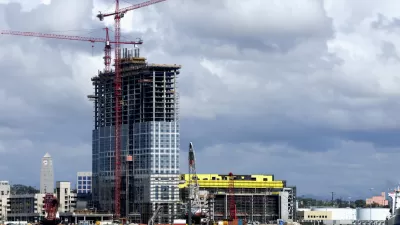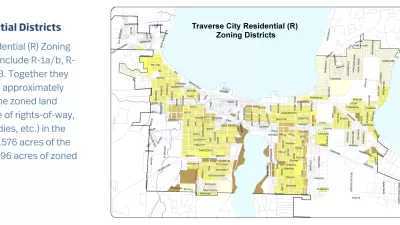A recent package of code changes by the city of San Diego will make it possible to build high-rise residential buildings and accessory dwelling units in larger areas around public transit.

The city of San Diego recently approved an ordinance that will allow high-rise apartment buildings and accessory dwelling units in a larger portion of the city by expanding the boundaries of zoning for transit oriented development from a half-mile to a mile radius around transit stations. Specifically, the expanded zoning districts will allow high-rise apartment buildings and accessory dwelling units on more parcels in the city.
David Garrick last week broke the news of the ordinance’s approval for the San Diego Union-Tribune and Globe St. also picked up the news this week. Planetizen shared news of the ordinance in January, before it went up for approval by the San Diego City Council.
Garrick’s article provides more insight into the debate that preceded the 5-4 vote that approved the ordinance. Opponents on the City Council argued that one-mile is too far to walk, and the ordinance would create congestion due to the additional car trips created by new residential density. Proponents argues that the zoning change would create opportunities for more housing affordable at low- and middle-incomes.
As noted by Garrick, the zoning changes discussed here were included in a package of 84 total municipal code changes. “The other changes include outlawing storage facilities in prime industrial areas, expanding where tasting rooms are allowed and making downtown more family-friendly with new incentives for three-bedroom apartments and child care businesses,” and “Additional changes approved Tuesday as part of the annual code update include tougher rules for new projects vulnerable to sea-level rise and stronger wildfire prevention rules for climate-friendly energy storage facilities.”
Garrick’s article, linked below, suggests that the zoning change came about as a response to pressure from state housing regulators during the Regional Housing Needs Assessment process, which has been upending planning the state of California for the past year, and will continue to do so for the foreseeable future.
FULL STORY: Badly needed homes, or ‘infill sprawl?’ City approves controversial plan for high-rises farther from transit

Montreal Mall to Become 6,000 Housing Units
Place Versailles will be transformed into a mixed-use complex over the next 25 years.

Planetizen Federal Action Tracker
A weekly monitor of how Trump’s orders and actions are impacting planners and planning in America.

DARTSpace Platform Streamlines Dallas TOD Application Process
The Dallas transit agency hopes a shorter permitting timeline will boost transit-oriented development around rail stations.

Study: 4% of Truckers Lack a Valid Commercial License
Over 56% of inspected trucks had other violations.

Chicago Judge Orders Thousands of Accessible Ped Signals
Only 3% of the city's crossing signals are currently accessible to blind pedestrians.

Philadelphia Swaps Car Lanes for Bikeways in Unanimous Vote
The project will transform one of the handful of streets responsible for 80% of the city’s major crashes.
Urban Design for Planners 1: Software Tools
This six-course series explores essential urban design concepts using open source software and equips planners with the tools they need to participate fully in the urban design process.
Planning for Universal Design
Learn the tools for implementing Universal Design in planning regulations.
City of Mt Shasta
City of Camden Redevelopment Agency
City of Astoria
Transportation Research & Education Center (TREC) at Portland State University
US High Speed Rail Association
City of Camden Redevelopment Agency
Municipality of Princeton (NJ)





























